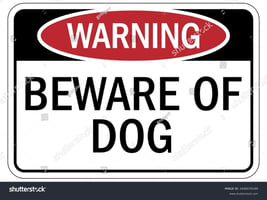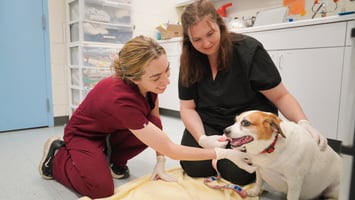Friends of the Cornell Riney Canine Health Center,
How to Brush Your Dog's Teeth - February 2025
Friends of the Cornell Riney Canine Health Center,
My dog Mishka and I have a rather predictable morning routine – coffee for me, then morning walks and breakfast. After that, Mishka knows it’s time to get her teeth brushed. With February being National Pet Dental Health Month, it’s the perfect time to think about how to improve your dog’s dental health and start making your own routine if it isn’t already in your practice.
Periodontal disease is one of the most common health issues in dogs. It can start as early as 1-2 years old, and if left unchecked, over time, it can lead to bad breath, gingivitis, pain and tooth loss. Regular tooth brushing helps slow tartar buildup and delay the development of dental disease. That’s why brushing your dog’s teeth is the most important step you can take to maintain their health. Of course, it’s not a substitute for professional cleanings by your veterinarian, but it’s a game-changer for your dog’s long-term health.
I think many pet owners like the idea of brushing their dog’s teeth but just don’t know where to start. For many, it’s one of those “easier said than done” scenarios. While some dogs may be more accepting of letting you do whatever to their mouth, it’s quite common for dogs to be wary of having their head touched, never mind the inside of their mouths! It certainly took Mishka and me plenty of time practicing before we got to where we are now.
So, how do you make toothbrushing easy, stress-free and even enjoyable for your pup? The first step is to think about tooth brushing as a training session. You shouldn’t expect to brush their teeth from start to finish on day one – in fact, I would avoid that! Let’s break it down so that brushing becomes a daily routine they actually look forward to and you can commit to.
Step 1: Set Up a Routine Spot & Time
Pick a consistent spot and time when you’ll brush your dog’s teeth. For me, I keep Mishka’s toothbrush and toothpaste in the bathroom near mine, so I remember to brush her teeth after I brush my own. I put down a bathmat, though you could use a towel, blanket, or dog bed, as a signal to her and where I want her to sit—it helps her recognize that it’s time for brushing.
Before you even start brushing, introduce your dog to the toothbrush by allowing your dog to lick a small amount of flavored pet-safe toothpaste off the toothbrush or straight from the tube while sitting on the mat. Repeat this for a few days so they get used to the taste and associate the mat and toothbrush with a positive experience. Doing this around the same time and spot each day helps build a routine for you and your dog—but daily consistency matters more than the exact time or place.
Step 2: Get Your Dog Comfortable with Handling
This, to me, is the most important step —many dogs are head-shy or not used to having their mouth handled. Our goal is for them to enjoy and participate in toothbrushing, not just tolerate it!
- Start by having your dog sit on the mat or spot you’ve chosen for tooth brushing. Lightly hover your hand above their head, barely touching their fur. Then, immediately reward them with a treat or a lick of toothpaste off the toothbrush.
- Once they’re comfortable with that, progress to gently placing your hand on top of their head, followed by a treat.
- Once they’re comfortable with their head being touched, work your way up to lifting their lip on their muzzle with your non-dominant thumb, then give the reward.
- Progress to pulling back their cheek at the corner of their mouth to expose their molars, then give the reward.
Step 3: Introduce the Toothbrush
Now that your dog is comfortable with their head and mouth being handled:
- Lift their lip and briefly touch a tooth with the toothbrush—then reward.
- Once they’re comfortable with that, introduce a few strokes of the toothbrush on a tooth and gradually increase the time the toothbrush brushes their teeth over multiple sessions.
It’s important to note that each bullet point of each step might take days or weeks, depending on your dog. The key is to go at their pace—if they pull away, slow things down. We’re aiming for long-term success, not quick wins.
Step 4: Start Brushing!
Once your dog is comfortable with all the steps, you can begin brushing the mouth one section of their teeth at a time. Keep sessions short and positive, slowly building up to brushing each quadrant of their mouth for longer durations over time.
Remember, consistency is key, so practicing daily is crucial! The entire process can take weeks to months, but with patience and commitment, your dog will look forward to brushing time. And before you know it, brushing their teeth will feel as natural as brushing your own!
As always, thank you for being a Riney Canine Health Center member. We look forward to catching up with you next month!
Dr. Aly Cohen
Extension veterinarian
Cornell Richard P. Riney Canine Health Center
Other resources:

-1.jpg?width=50&name=Aly%20in%20RCHC%20shirt%20(+%20Mishka)-1.jpg)



